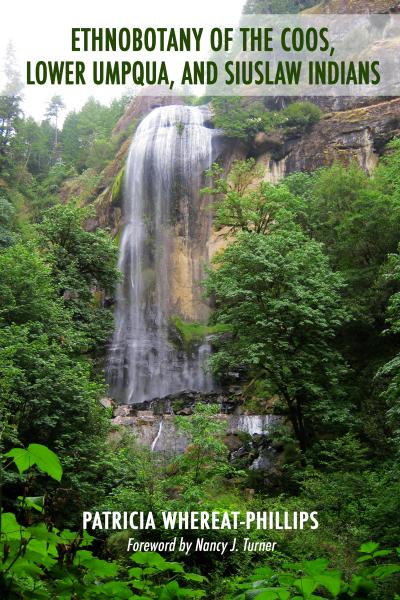If you’ve ever studied a second language, you’ve probably heard, “If you don’t use it, you lose it.” While some people may feel unaffected that they no longer remember the language they learned in secondary school, entire cultures suffer when the last speaker of that language dies and the language is lost. There is a great importance behind understanding cultures and their practices. This includes how the culture connects with the environment around them. Today Patricia Whereat-Phillips discusses her introduction to research focused on indigenous languages and how she became interested in ethnobotany. In her new book, Ethnobotany of the Coos, Lower Umpqua, and Siuslaw Indians, Whereat-Phillips documents the ethnobotany of western Oregon indigenous peoples.
___________________________________________________________________________________
Growing up in the hills near the eastern shore of Coos Bay, I spent much of my childhood playing out in nature – playing in the stream at the bottom of the draw, watching deer eat apples in our yard, helping mom fill the bird feeders, and spending all summer wandering the land around our house picking berries. As a child, I learned that I was descended from the Milluk people of lower Coos Bay. I wondered what the old language was like, but no one seemed to know. The last fluent speaker of Milluk died before I was born, and the last speaker of its sister language, Hanis, died when I was 2 ½ years old. I never met her.
For years my research focused on indigenous languages – mostly the Coosan languages of Hanis and Milluk, and Siuslaw, and traditional legends. My interest in ethnobotany began when I received a letter from an undergraduate who was researching medicinal plants of Oregon Indians. It wasn't a question I'd looked in to before, and I began to do some research. I found a few mentions of medicinal plants, and answered her letter. By now, my curiosity piqued, I tried to do some more research and found (probably as this student did) that there is little published on western Oregon ethnobotany (unlike the rest of the Pacific Northwest and California).
So I spent years trying to research the ethnobotanical knowledge of the Coos, Lower Umpqua, and Siuslaw. Not only did I gain a greater appreciation of the beauty and diversity of the temperate rainforest that I had grown up in, but a greater appreciation of the breadth of indigenous knowledge of the landscape and the melding of ethnobotany with language and story.
Take, for instance, the quirky skunk cabbage, known to science as Lysichiton americanus. It is an unmistakable plant as there is nothing else in our region that looks – or smells – quite like it. In early spring bright yellow 'lanterns' emerge from mucky earth, followed by waxy green leaves that can grow more than three feet long. And its odd smell, which gives it its English name, is unique and to some people unpleasant. To our ancestors, skunk cabbage was a medicine, food, and part of the mythological world. Our stories tell us that in the beginning, the First Trickster set the precedent for how to cook skunk cabbage roots. He was hungry, tried to eat the skunk cabbage root raw, but it didn't taste good. In a moment of anger he shoved it into the hot ashes of his fire. Soon he smelled something sweet. He removed the root from the ashes, and found that it tasted sweet. He began to cut up the root. As he picked up each piece, he said “Give this to your father, give this to your mother...” He continued on and on until he had named all the kinship terms. In one act he let it be known that skunk cabbage root was no good but had to be roasted until it smelled sweet, and he created the idea of and terms for family relationships.
For generations, women gathered the roots in spring and early summer. The roots were more than just food, however; they could also be medicine. In my family, my great grandmother was the last person to use this medicine. Her method was to grind up the root, mix it with some honey, and give a spoonful to her relatives suffering from a cold.
Over the last few years I have been able to learn much about traditional culture and native plants. It has also been amazing to see the cultural renaissance during this time – more and more Native people of western Oregon have been bringing back traditional canoes, weaving, carving, songs and stories.
Related Titles

Ethnobotany of the Coos, Lower Umpqua, and Siuslaw Indians
Myrtlewood is most often thought of as beautiful wood for woodworking, but to Native people on the southern Oregon coast it was an important source...
